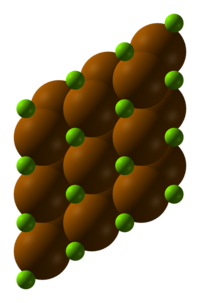Chemistry:Magnesium polonide
From HandWiki

| |
| Names | |
|---|---|
| Preferred IUPAC name
Magnesium polonide | |
| Identifiers | |
3D model (JSmol)
|
|
| |
| |
| Properties | |
| MgPo | |
| Molar mass | 233.29 g/mol |
| Appearance | greyish[1] |
| Density | 6.7 g/cm3 (XRD)[2] |
| Structure[2] | |
| NiAs, hP4, No. 194 | |
| P63/mmc | |
a = 0.4345 nm, b = 0.4345 nm, c = 0.7077 nm
| |
Formula units (Z)
|
2 |
Except where otherwise noted, data are given for materials in their standard state (at 25 °C [77 °F], 100 kPa). | |
| Infobox references | |
Tracking categories (test):
Magnesium polonide (MgPo) is a salt of magnesium and polonium. It is a polonide, a set of very chemically stable compounds of polonium.[3]
Preparation
Magnesium polonide can be produced by heating a mixture of elemental magnesium and polonium at 300–400 °C.[1]
Structure
Magnesium polonide has the nickeline (NiAs) structure.[1][3] It is unusual among polonides in not being isomorphous with the corresponding sulfide, selenide and telluride; only mercury polonide (HgPo) shares this property.[2]
References
- ↑ 1.0 1.1 1.2 Bagnall, K. W. (1962). "The Chemistry of Polonium". Advances in Inorganic Chemistry and Radiochemistry. New York: Academic Press. pp. 197–230. ISBN 9780120236046. https://books.google.com/books?id=8qePsa3V8GQC.
- ↑ 2.0 2.1 2.2 Witteman, W. G.; Giorgi, A. L.; Vier, D. T. (1960). "The Preparation and Identification of Some Intermetallic Compounds of Polonium". Journal of Physical Chemistry (American Chemical Society) 64 (4): 434–440. doi:10.1021/j100833a014.
- ↑ 3.0 3.1 Greenwood, Norman N.; Earnshaw, Alan (1984). Chemistry of the Elements. Oxford: Pergamon Press. p. 899. ISBN 978-0-08-022057-4. https://books.google.com/books?id=OezvAAAAMAAJ&q=0-08-022057-6&dq=0-08-022057-6&source=bl&ots=m4tIRxdwSk&sig=XQTTjw5EN9n5z62JB3d0vaUEn0Y&hl=en&sa=X&ei=UoAWUN7-EM6ziQfyxIDoCQ&ved=0CD8Q6AEwBA.
 |

